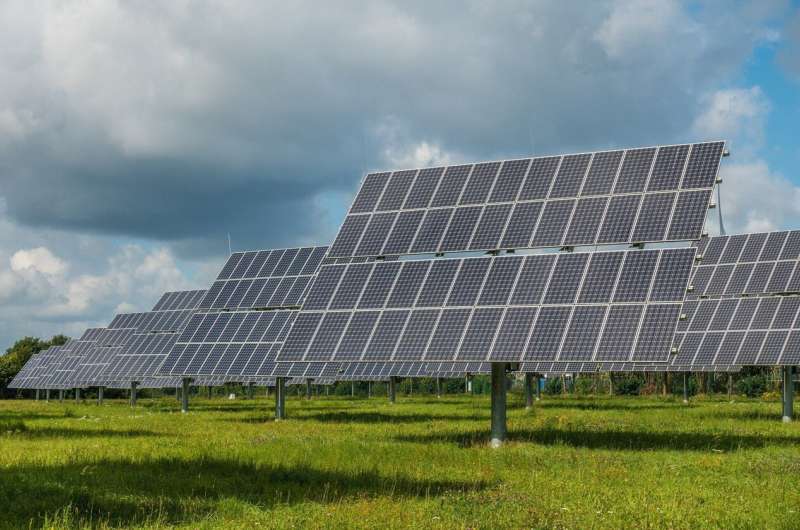This article has been reviewed according to Science X's editorial process and policies. Editors have highlighted the following attributes while ensuring the content's credibility:
fact-checked
peer-reviewed publication
trusted source
proofread
Returning solar panel production to US can ease climate change, says new study

Domestic production of solar panels—most of which are now made in Asia—can speed up decarbonization in the U.S. and reduce climate change faster, according to new Cornell Engineering research published March 8 by Nature Communications.
"If we bring the solar panel manufacturing back to the U.S., it helps us realize decarbonization goals faster," said Haoyue Liang, a doctoral student in systems engineering, who co-authored "Reshoring Silicon Photovoltaics Manufacturing Contributes to Decarbonization and Climate Change Mitigation" with Fengqi You, the Roxanne E. and Michael J. Zak Professor in Energy Systems Engineering.
"As solar photovoltaic panels emerge as a major power source that will characterize the U.S. energy market for the remainder of the 21st century," Liang said, "manufacturing and sourcing panels here will align with our climate targets and our energy policy goals."
Manufacturing crystalline silicon photovoltaic panels in the U.S. solves logistical challenges and eases greenhouse gas problems, according to the paper.
The scientists analyzed production in the U.S. to learn how it could shrink greenhouse gas emissions and energy use. If solar panel manufacturing can return to the U.S. by 2035, the greenhouse gas emissions resulting from panel creation would be reduced by 30% and energy consumption would be cut by 13%, compared to 2020, when the U.S. relied almost entirely on international trading partners.
By 2050, the solar panels made and used in the U.S. will be more efficient, and will reduce the carbon footprint by 33% and use 17% less energy than solar panels sourced globally in 2020.
The climate-change mitigation forecast would be fulfilled by both reshoring the solar panel manufacturing back to the U.S. and having mostly renewable energy on the power grid, which is anticipated in the next decades.
Based on projections about the energy decarbonization transition that happens alongside reshoring, You said, the U.S. will see a larger share of renewable power accounting for primary energy consumption and an overall lower primary energy consumption over the years for solar panel manufacturing.
The federal Inflation Reduction Act—signed into law in August 2022—provides $369 billion in business incentives and tax credits to build a clean energy economy, according to the White House. In addition to wind turbines and grid-scale battery plants, the act provides for the production of than 950 million solar panels.
In 2022, about 4.24 trillion kilowatt hours of electricity were generated domestically at utility-scale plants in the United States, according to the U.S. Energy Information Administration. About 22% of that electricity came from renewable energy sources, but only 3.4% was generated from solar power.
"By 2050, around half of U.S. electricity will come from solar energy. Now, we only have about 3%," You said. "The U.S. is ramping up. We are going to increase solar capacity from 74 gigawatts in 2022 to a projected 1,600 gigawatts by 2050. That means we will need a lot more panels in the next three decades."
The global supply chain for crystalline silicon photovoltaic panels is increasingly fragile, You said, as the recent shipping crisis during the pandemic and other geopolitical risks threaten to postpone major solar projects.
"The effects of supply chain restructuring continue to propagate throughout the photovoltaic industry," he said, "as the overreliance on global trade structure emphasizes disruptions that jeopardize all countries involved."
The new paper creates reasonable predictions for scenarios that involve a U.S.-centered domestic supply of panels, which could lead to a competitive supply chain of solar panel module components production in regions like Alabama, Florida and Georgia.
"When you consider the solar panel industry will grow by a factor of over 10 until mid-century, those greenhouse gas emission savings could be quite significant," said You, who is also a senior faculty fellow at Cornell Atkinson Center for Sustainability.
More information: Haoyue Liang & Fengqi You, Reshoring silicon photovoltaics manufacturing contributes to decarbonization and climate change mitigation, Nature Communications (2023). DOI: 10.1038/s41467-023-36827-z. www.nature.com/articles/s41467-023-36827-z


















